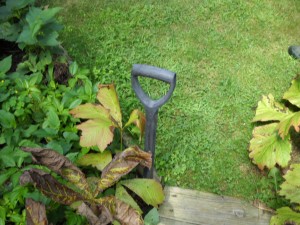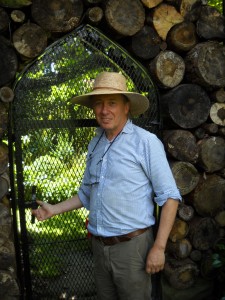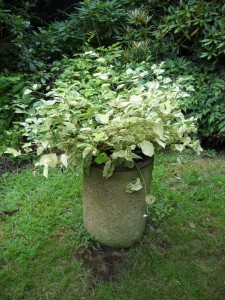The Bane of Many Gardeners: Japanese Knotweed
Posted on Tuesday, January 25, 2022 · Leave a Comment
I’m a lucky guy: for one thing, I have no Japanese knotweed. Many is the gardener who has e-mailed me asking, “What can I do to get rid of Japanese knotweed?” My usual answer? Sell the house.

Japanese knotweed is an attractive plant, but nearly impossible to get rid of
Japanese knotweed, commonly called bamboo because of its hollow, segmented stems, goes by a number of scientific names, most commonly Polygonum cuspidatum. The leaves are heart-shaped and alternate on the stems, which can reach up to 10 or even 15 feet tall. It was introduced from Japan as a landscape plant in the late 1880’s, and was sometimes planted for erosion control, but quickly proved invasive.
Japanese knotweed spreads easily: its rhizomes (roots) can go 90 feet or more – even popping up through asphalt or pushing through house foundations. I talked to someone who tried to dig out a patch that had been growing for decades by using with a backhoe; he quit after digging down eight feet because he saw roots going even deeper!
Japanese knotweed blooms in early fall with white blossoms that attract bees and other pollinators. The small seeds are carried by wind, water or animals, though research shows that seeds are not usually how it propagates. It spreads by root – even a small bit of root can create a new patch of knotweed, so it is a problem along streams and rivers because flooding can send its invasive roots to new sites miles away. Sometimes highway departments move soil with roots, and it spreads.
Invasive plants (like knotweed) are defined as those coming from a different continent with few or no natural predators here. The bugs that eat purple loosestrife or Japanese knotweed did not come with them when they first made it to our shores. Invasives spread rapidly and can outcompete our native plants for sun, moisture and soil nutrients.
Most invasives can grow in sun or shade in wet or dry soil. They do not need that dark, organic matter-rich soils that we offer our peonies. Invasives, generally, can grow in your gravel driveway if given half a chance.
Most invasives are hard to control for several reasons. Most have extensive root systems that spread far and wide, and are often brittle. Trying to dig out the roots generally results in new plants from scraps of root that broke off, and that is certainly the case for knotweed.
I recently called Pete Butler, an arborist living in Stockbridge, Vermont to talk about Japanese knotweed. Last summer I had visited one of his projects, a public park along the Ottauquechee River in Woodstock, VT, to look at his efforts controlling knotweed.
Pete said that the best time to attack a patch of knotweed is in the fall, when the plants are less vigorous and new shoots are less likely to grow after the roots are disturbed. Dig out root masses to get as much root as possible. The roots show bright orange if scraped with your shovel. They are woody and large in a well-established patch. “You’re not going to dig it all out successfully. But taking away a lot of the root mass is like a good punch in the nose,” according to Pete.
He emphasized that you should never get rid of your excavated knotweed roots by taking them away. Destroy them on site by burning them. He takes dead trees, branches from pruning and other wood products to start a hot bonfire that will destroy the knotweed. If you truck it away, it will start growing elsewhere, spreading the problem.
After digging, he said, add some competition. He uses winter rye, planting in the fall. It scavenges nitrogen and starts rebuilding soil that the knotweed has depleted. He also adds fertilizer to improve the soil. In spring the winter rye starts growing early, as does the knotweed. The grass stabilizes the soil and helps re-introduce microbial life, he said.
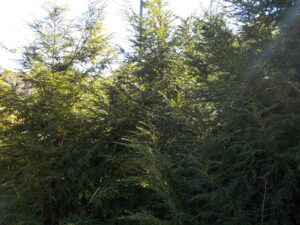
Hemlocks have out-competed knotweed in this site
Getting a soil test will help you determine how badly your soil has been degraded by the knotweed so you can improve it. In the spring he likes to add more grass seeds, particularly sheep fescue and hard fescue. These grasses compete with the little sprouts of knotweed from root scraps that evaded your digging. He does not mow the grasses, which are relatively short.
Pete Butler explained that he uses an IPM or Integrated Pest Management approach to controlling knotweed, including micro-doses of herbicides, just “ounces per acre”. He is a licensed to apply pesticides, to help in the process, but cautions that homeowners should not attempt using herbicides. Even herbicides like Round-Up, widely touted as safe, can have negative impacts on beneficial plants and soil fungi.
Get control of a knotweed infestation will take at least three years, Pete said, and each year he uses less herbicide. The “shelf life” of the roots is about 9 years he said, after which they will no longer be viable. Until that time, a site needs to be carefully monitored and appropriate steps taken each year.
When I visited his knotweed control site last summer Pete showed me how competition can help control knotweed. He planted a clump of hemlocks about six-feet tall, shoulder-to-shoulder after removing knotweed roots. They effectively outcompeted the knotweed, even if not completely eliminating the few new shoots that appear each year. He applies micro-doses of herbicide to finish it off.
Knotweed does best in full sun and moist soil, so creating shade near a site will slow it down some. And human activity can discourage it, too. High foot traffic will slow it down.
So maybe you don’t have to sell your house just because you have knotweed. But be prepared to battle it for years. And for those of us committed to organics, we may have to live with a little knotweed.
Henry lives And
gardens in Cornish Flat, NH. E-mail him at
henry.homeyer@comast.net. He is the author of 4
gardening books.
Getting Rid of Invasives
Posted on Tuesday, January 21, 2020 · Leave a Comment
My mother used to say, “The road to hades is paved with good intentions.” That is particularly true for gardeners and plant collectors. Most of those nasty invasive plants we struggle to eliminate from our landscape were brought here from abroad by people who didn’t know better. They thought the plants would be a useful addition to their landscape. Plants such as barberry, Japanese knotweed and burning bush looked great to them. What they didn’t bring, of course, were the insects that eat them and keep their numbers under control in their native environments.
January is down time in the garden, generally. We can’t plant anything, and often the snow is deep. But if the January thaw has melted away the snow and ice where you are, this is a time when you could work on getting rid of some invasive trees and shrubs.
Actually, what I have I mind is helping to reduce the vigor and number of mature plants by cutting them down. That won’t kill them, but will keep them from producing seeds next year or even longer. Most invasives have roots that will send up new sprouts, come spring. And winter is not a time when you can dig up or pull out roots. But cutting them down and burning them is a chore you can do now.
The first task you have in this effort is to learn to identify the plants. For me, the most common invasive plants in the woods around my home are bush honeysuckle and barberry.
Invasive bush honeysuckle can get to be 10 to 15 feet tall and wide. It has fragrant white blossoms in June and oval-shaped leaves that are opposite each other on small twigs. In winter the bark is distinctive – slightly shaggy with distinctive ridges. If you cut a stem, there is a hollow spot in the center of the stem, though it might only be the diameter of a pencil lead. The shrub produces red or orange berries.
Japanese barberry is a tough plant that I have seen in deep woods, far from homes or roads. In full sun it produces massive quantities of red berries that birds eat and then drop the seeds all over. The bush has small green or purple leaves and is dense with thorns. I visited a barberry hedge recently, and it was still loaded with berries. The best solution? Cut it down now, and dig out the roots in the spring.
Burning bush ( Euonymus a) is on invasive species lists throughout New England, even though I rarely see seedlings in the woods, and have none on my property. It is best identified in the fall, when its scarlet leaves are noticeable. It is more of a problem in Rhode Island, Connecticut and Massachusetts. I once saw a bumper sticker that said, “30 Below Keeps Out the Riff-Raff. I assume it was talking about plants like burning bush which survives here, but doesn’t spread as fast as it does in warmer climes.
Buckthorns are small trees or large shrubs that are very difficult to eliminate. If you cut one down, the root system will send up many, many new shoots, come spring.
There are two different species of buckthorn common in New England: common buckthorn (Rhamnus cathartica) and glossy buckthorn (Rhamnus frangula), a smaller version with pretty shiny leaves. Both produce berries that turn a deep purple and are the size of blueberries, put with a pit in the middle like a cherry.
You can kill these two by double girdling the trunks with a hand saw, cutting through the bark and green cambium layer while avoiding the dense heartwood. By double girdling, I mean cutting two lines all the way around the stem a foot apart or so. If you do it now, the plants will leaf out and grow normally this year, and perhaps even next year, but then they will die – without sending up new shoots. I have done this.
By cutting through the cambium layer, no nutrients will be sent to the roots, and the roots eventually starve. Common buckthorn is often multi-stemmed with stems close together, so getting a saw in around each stem can be difficult.
Why bother with all this? First, although birds may eat the berries of invasive plants and distribute their seeds, they did not evolve with the plants and often do not benefit much from what they eat. The invasives also out-compete many of our own native plants. They leaf out earlier in the spring and drop leaves later in the fall than our natives. They often shade out or disrupt the growth of wild flowers, too.
Invasive trees and shrubs may be less attractive to the caterpillars that feed on our native trees and shrubs, and which are such an important food source for baby birds. Butterflies and moths lay their eggs on the leaves of native woody plants so that their caterpillar babies will eat well. Those caterpillars make up the vast majority of food for nestlings, even those species that develop into seed eaters. So avoid growing invasives.
Take advantage of the January thaw – or a thaw anytime this winter – and remove some invasive plants. Get a burn permit, some marshmallows and do your woods some good. And have fun!
Henry is the author of 4 gardening books. You can email him at henry.homeyer@comcast.net.
Dealing with Invasives
Posted on Wednesday, August 21, 2013 · Leave a Comment
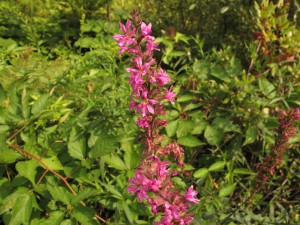
Purple loosestrife closeup
I’m sure you know purple loosestrife, even if you don’t know its name. It’s a big, tall clumping plant bearing bright pinkish-purple flowers and it’s appearing now in your neighborhood, especially in wet areas. What you may not know is that it’s an aggressive foreign invader that can out-compete many of our native species. It has been around for a couple of centuries – it came over, allegedly, in soil used as ballast in sailing vessels in the late 1700’s.
But if it grows well and it’s pretty, what’s the problem, you may wonder? A number of things. It’s a big plant that can dominate the landscape and shade out smaller, less vigorous native plants. A mature loosestrife can produce up to a million seeds, seeds that can be carried by streams to new locations. Wildlife can be negatively impacted. Many insects and birds depend on native plants for food and nesting materials- native plants that evolved with them. Invasives like purple loosestrife often do not meet their needs.
According to Barbara McIlroy of Etna, NH, who has been active in the movement to control invasive species, the number of bird and butterfly species present on properties that grow native species is much, much higher. “I’m converted,” she told me. “Grow natives. Period. The positive effect on the wildlife is dramatic.”
Unfortunately, it’s almost impossible to rid your property of purple loosestrife. These plants have amazingly tenacious roots. Before I knew better I tried digging out some large plants from a swampy area on my property. Yes, I got the plants out – but some of the roots broke off and re-sprouted. And by clearing out a space, I also opened up a new site for seeds to grow. If you have had purple loosestrife in the past, there are seeds waiting for a chance to germinate – like little time bombs.
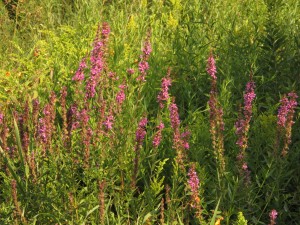
Loosestrife
But there is good news: two species of beetle (Galerucella calmariensis and G. pusilla) have been approved for and found effective in controlling purple loosestrife. These beetles cannot eliminate the loosestrife, but can reduce the numbers dramatically. Loosestrife is not a problem in Europe the way it is here, in part because it has natural enemies – the beetles. By introducing the beetles, an effort has been made to help Mother Nature keep loosestrife under control. Once established, they eat enough of the leaves and stems that the plants do not bloom. And theses beetles have been well tested: they will not eat your garden plants or valuable crops.
In 2001 Saint-Gaudens National Historic Site in Cornish, NH released two species of beetles to see if they could control the purple loosestrife that was taking over the wetlands at Blow-Me-Down pond. I met recently with Steve Walasewcz, who monitored the effort from 2001 to 2008. He explained that the beetles did not have an immediate effect. In fact, from 5.75 stems per square meter in 2001, the numbers increased to 10.5 by 2003. But then they declined each year until reaching only 1.05 in 2008 – a tenth the number of stems.
I went to the area where the beetles were released in 2001 and although there were a few blooming stems of purple loosestrife, there were very few. According to a report done for Saint-Gaudens NHS, it is believed that even low numbers of beetles prevent flowering; at higher numbers, “the beetles can strip the plants of its photosynthetic layer, resulting in high mortality in the winter due to a depleted starch reserve.”
Unfortunately, the beetles are not readily available for purchase. But for several years I have been experimenting with my own way of controlling the problem near my brook. Each year in early July I take pruners and cut back the plants to the ground. I identify them by their square stems that have a reddish color near the ground, and of course their leaves. Then a month later, I do it again – in essence, acting like a beetle. By cutting back the plants, few are able to bloom, greatly reducing the number of seeds spilling into my environment.
As a second step, I planted some big, tall native plants that I hoped would compete with the purple loosestrife: Joe Pye weed (Eupatorium purpureum) and Canadian burnet (Sanguisorba canadensis). I also added marsh marigold (Caltha palustris), which though not tall, is tough. These natives have given purple loosestrife a run for its money. Instead of filling 3 wheelbarrows with cut loosestrife in early July, I was able to get it all in one.
Purple loosestrife is just one of many invasive plants. If you see a new, vigorous plant show up on your property, try to learn its name and find out if it’s a problem elsewhere. Meanwhile, there is good news: scientists are working on biological controls for both Japanese knotweed (commonly called bamboo) and garlic mustard. In England, certain beetles are now well established to reduce the vigor of Japanese knotweed.
Henry Homeyer is the author of 4 gardening books and a new children’s fantasy-adventure about a boy and a cougar. His web site is www.Gardening-guy.com.
Weeds … Alien Invaders or Plants Just Looking for a New Home?
Posted on Wednesday, January 23, 2013 · Leave a Comment
It’s winter, and I have time to get caught up on my reading. When I was in Wales last fall I made a book-lovers pilgrimage to Hay-on-Wye. This is a town of 1,500 to 2,000 souls with at least 28 independent bookstores, mostly stores selling used books. That’s about a bookstore for every 50 people living there! Needless to say, it attracts lots of booklovers, especially in June when it has a book festival.
I spent 2 days poking around bookshops looking for weird and wonderful books and found plenty. Among them was a book on weeds, Weeds: The Story of Outlaw Plants by Richard Mabey (Profile books, 2010).
The author is a British nature writer with an interest in plants, especially weeds. Weeds, he explains, are opportunists. Cities are full of weeds growing in the most unlikely places: between the cracks of the sidewalks or walls, in abandoned lots – and once a weed seed even germinated in someone’s eye! Wherever they find a niche, they grow. Many can produce large numbers of seeds or are able to spread by roots that wander; most have arrived from distant countries.
We gardeners know, as he points out, that weeds move in when we disturb the soil – to plant a tomato or to create a flower garden. But a weed, according to Mabey, is just a plant growing where we want to grow something else, or nothing at all. I liked his quote from Ralph Waldo Emerson that a weed is “a plant whose virtues have not yet been discovered”.
In late fall I got an email from a friend asking me to identify a weed that had been troublesome in his cold frame. “I attach an image, as I do not even know the name of this curse to the garden world, this Medusa which has been defying eradication. Can you put a name to this curse with an idea how to best cope with it?”
I told him that his bane was chickweed (Stellaria media), and that it is edible – some people use it like lettuce or steam it like spinach. Once he knew that, he changed his attitude 180 degrees. Which is lucky, as he did some research and found that chickweed can bloom 5 times per year with each plant producing up to 20,000 seeds that can remain viable in the ground up to 40 years. He emailed that, “I guess I might as well enjoy the fact that it is edible and is most profuse at a time of the year (early December) when there is not much else edible growing vibrantly.”
But back to Richard Mabey’s book on weeds. I learned that Kentucky bluegrass is not originally from Kentucky, but arrived from Europe where it is a not-very-prominent meadow grass. But it found different conditions here in the new world, and thrived.
Speaking of lawns, some gardeners, I think, could enjoy life a lot more if they accepted weeds a little more. I’m pretty lax about weeds in my lawn – I don’t remove them unless, like thistles, they can hurt bare feet. If they’re green and can be mowed, they’re okay by me. I like dandelions, I think they’re cheerful. I don’t understand the desire to poison them or dig them out.
In another bit of trivia, I learned that the common burdock (Arctium lappa) inspired a Swiss inventor, George de Mestral, to create velcro. According to Mabey’s book, Mestral came back from a walk with his dog and studied the burrs attached to its fur – and realized that it could be copied in nylon. He patented Velcro in 1951.
Weeds, Mabey pointed out, are highly adaptable. In a relatively few generations they can modify their color, height, or seed size to fit in with agricultural crops – disguising themselves, as it were, to avoid being eliminated. And some are positively vicious. Field bindweed (Convolvulus arvensis), which resembles morning glories, not only monopolizes soil nutrients, it exudes pheromones that inhibit germination of most grain crops. Quack grass (Agopyron repens) produces a toxin that can poison corn.
But many “weeds” invade our spaces and become a part of our acceptable plant palette. The state flower of Vermont is red clover, which is not a native flower, for example. Mabey is all for giving “naturalized” citizenship to those weeds that can be useful to us, like that chickweed mentioned above. There are just a few that he singles out as truly scary.
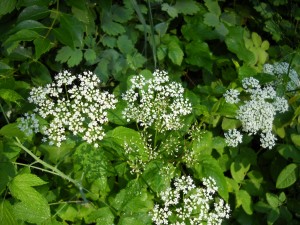
Goutweed
First on the scary list is kudzu, a Japanese vine that has become a real pest down South. Unless/until global warming gets much worse, we don’t have to worry about it here. But we have Japanese knotweed, also known as bamboo. He says an insect predator is being tested in England as a way to control it, but at present there really is no easy way to get rid of it– even for gardeners who are willing to use chemical poisons on it. And he writes about my nemesis, goutweed (Aegopodium podagraria). Ugh! I thought I had beaten it once by digging it all out and replacing 12 inches of soil, but after a few years it came back.
So enjoy your winter, and try not think about the weeds that are just waiting, like us, for spring. Either that, or get your house ready to go on the market if you have goutweed or Japanese knotweed.
Henry Homeyer is the author of a new children’s book, Wobar and the Quest for the Magic Calumet. His web site is www.henryhomeyer.com.
Now that I’ve put my garden to bed, I have time to think back about gardens I visited during the summer – and decide what I should try next summer. This year I had the great good fortune to spend 3 hours at Sakonnet Garden and Wildmeadow, the gardens of John Gwynne and Mike Folcarelli in Little Compton, Rhode Island. For the past 30 years they have been making and re-making gardens on about an acre of what started as a cornfield surrounding an early 1900’s Cape. They prove the point that a garden is never done: there is always something new to try.
I asked John what his garden passions have been. He said he loves playing with light in the garden: creating spaces – garden rooms – that are either bright and colorful or dark and shady. He creates special effects with plants – enclosing silver-foliaged plants with dark green hedges, for example. He enjoys showcasing dramatic plants, placing them in full sun at the end of a long dark path. He is also passionate about restoring meadows so that birds like bobolinks and meadowlarks can breed and succeed.
Like me, John is a plant collector, and one who tests plants to find which ones grow and look the best. At one point he and Mike had 500 rhododendrons, for example. They have thinned that collection down to “just” 100 or so.
As I walked through the gardens I made notes of things I might like to try, both plants and planting techniques. One of the first things I noted was their capricious use of unusual items as hose guards. Hose guards allow you to drag a 100-foot hose through the garden and go around corners without knocking over or damaging plants. They used baseball bats half buried in the soil and antique croquet wickets. I really liked their use of tool handles – old shovel handles that had snapped off – as hose guards. It is recycling at its best.
The gardens are divided up into rooms with walls, generally at least 6 feet tall. Some were made of living material –hedges or vines on trellises – and others were made from a variety of non-living materials, including stone.
One wall that caught my attention was made of logs. Logs – suitable as firewood – were simply stacked up, each piece about 2 feet long. The wall was a good 8-feet tall and made of logs that varied in diameter from an inch to six inches or more. There is a door that leads out of the room – with a gate. An iron frame that supports logs over the door; the door itself was made of flat welded iron with metal screening attached.
Training vines can be tricky, especially if you want them to travel laterally through the air. The solution they found was to roll out 25 feet or more of chicken wire, then shape it into a long roll. A three-foot width of chicken wire, when rolled up tightly, makes a form that is structurally strong enough to be suspended between trees or walls and support vines. They intermingled 2 plants: winter creeper ( Euonymus fortunei) and Japanese holly (Ilex crenata), training them to flow through the air.
John and Mike grow a number of plants that are generally considered invasive pests – things like giant hogweed (Heracleum mantegazzianum) and a variegated-leafed form of Japanese knotweed (Polygonum cuspidatum). And although I do not recommend using such plants, they have figured out ways to do so – and to contain them responsibly.
Giant hogweed grows to be 6-10 feet high and has flowers that can exceed 2-feet in diameter. They are careful to pick the flowers before they go to seed, thus preventing them from spreading. Me? I grew it before I knew better, and was able to eradicate it when I learned it can be invasive. It will grow in sun or shade, wet or dry, and has roots that go down 3 feet or more into the soil. I still watch for it, and occasionally an old seed will germinate and create another plant.
Japanese knotweed (seen along roadsides and streams and commonly called ‘bamboo’) spreads by root, so they contain it in sections of concrete well pipe – the kind that is used to contain shallow hand-dug wells. Each piece of the pipe is 30 inches in diameter and 3-4 feet long. The pipe makes a terrific planter – it is simple, sturdy, and creates a root zone deep enough for most plants, but also deep enough to contain wandering invasives.
Their garden also uses snow fence as walls for rooms. Most snow fence is 4-feet tall, but they special order 6-foot snow fence made by Griffin Fence Company in Griffin, Georgia and have it shipped to them. They support the fencing with 4-inch square posts and grow vines or hedges to make the fencing disappear, especially since they paint it black. It works well for them as deer proofing.
If you’d like to see these phenomenal gardens, John and Mike will be holding a series of open days next summer, and possibly a day of workshops next spring. Their Web site, www.sakonnetgarden.com will list the dates of their upcoming events – though the Web address may change by spring.
I will never have the time and energy to build gardens as fine as those of Mike and John, but next summer I hope try to try some of their ideas.








